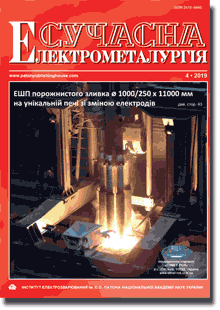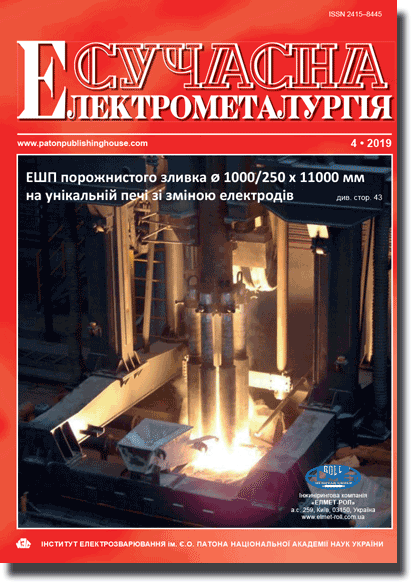| 2019 №04 (06) |
DOI of Article 10.15407/sem2019.04.07 |
2019 №04 (08) |

"Suchasna Elektrometallurgiya" (Electrometallurgy Today), 2019, #4, 44-50 pages
Journal SEM
Publisher International Association «Welding»
ISSN 2415-8445 (print)
Issue № 4, 2019 (November)
Pages 44-50
Structure of intermetallic titanium alloy of Ti–Al–Nb–Cr system
V.A. Kostin, G.M. Grigorenko
E.O. Paton Electric Welding Institute of the NAS of Ukraine. 11 Kazymyr Malevych Str., 03150, Kyiv, Ukraine. E-mail: office@paton.kiev.ua
The paper deals with alloys based on titanium aluminides, which are modern promising materials for manufacturing parts and mechanisms in ship-building, mechanical engineering, aviation and aerospace engineering. Cold-hearth electron beam melting is the main method to produce sound ingots of intermetallics based on Ti–Al system. Structure and properties of an intermetallic alloy of Ti–Al–Nb–Cr system were studied, and calculated equilibrium state diagram was plotted. It is shown that in the ingot central part the alloy structure consists approximately of 85…90 vol. % of (γ + α2)-phase, massive sections of γ-phase of about 10 vol. %, as well as small fraction of 3…5 vol. % of cubic B2-phase, located along the grain boundaries. CALPHAD methodology was used to plot the equilibrium ternary state diagrams of Ti–Al–Nb–Cr systems. Ref. 15, Tabl. 2, Fig. 4.
Key words: titanium alloys; electron beam melting; intermetallics; titanium aluminides; phase transformations; ternary state diagrams
Received: 26.11.19
Published: 23.09.19
References
1. Iliin, A.A., Kolachev, B.A., Polkin, I.S. (2009) Titanium alloys. Composition, structure, properties: Refer. Book. Moscow, VILS-MATI [in Russian].2. Clemens, Н., Mayer, S. (2013) Design, processing, microstructure, properties and applications of advanced intermetallic TiAl alloys. Advanced Engineering Materials, 15(4), 191-215. https://doi.org/10.1002/adem.201200231
3. Lipsitt, H. A., Shechtman, D., Schafrik, R. E. (1975) The plastic deformation of TiAl. Met. Transact. A., 6, 1991-1998. https://doi.org/10.1007/BF03161822
4. Paton, B.E., Trigub, N.P., Akhonin, S.V. (2008) Electron beam melting of refractory and high-reactive metals. Kiev, Naukova Dumka [in Russian].
5. Paton, B.E., Trigub, N.P., Akhonin, S.V., Zhuk, G.V. (2006) Electron beam melting of titanium. Kiev, Naukova Dumka [in Russian].
6. Trigub, N.P., Derecha, A.Ya., Kalinyuk, A.N. (1998) Refining of titanium in electron beam furnaces with cold hearth. Problemy Spets. Elektrometallurgii, 2, 16-20 [in Russian].
7. Tikhonovsky, A.L., Tur, A.A., Kravets, A.N. et al. (1992) Electron beam installation UE-208. Ibid., 1, 71-74 [in Russian].
8. Kablov, E.N., Lukin, V.I. (2008) Intermetallics based on titanium and nickel for advanced engineering products. The Paton Welding J., 11, 65-70.
9. Saunders, N., Miodownik, A.P., Cahn, R.W. (1998) CALPHAD - Calculation of phase diagrams. Pergamon Materials Series, Vol. 1, Elsevier Science, Oxford.
10. Fan, Z., Tsakiropoulos, P., Miodownik, A.P. (1994) A generalized law of mixtures. J. Mater. Sci., 29, 141-150. https://doi.org/10.1007/BF00356585
11. Lukas, H.L., Fries, S.G., Sundman, B. (2007) Computational thermodynamics: The Calphad method. Cambridge, U.K., Cambridge University Press. https://doi.org/10.1017/CBO9780511804137
12. https://www.matcalc.at/images/stories/Download/Database/mc_al_v2.029.tdb
13. Hari Kumar, K.C., Wollants, P., Delaey, L. (1994) Thermodynamic calculation of Nb-Ti-V phase diagram. Calphad, 18(1), 71-79. https://doi.org/10.1016/0364-5916(94)90008-6
14. Liang, Y., Guo, C., Li, C. (2008) Thermodynamic modeling of the Al-Cr system. J. Alloys Compd., 460(1-2), 314-319. https://doi.org/10.1016/j.jallcom.2007.06.046
15. Witusiewicz, V.T., Bondar, A.A., Hecht, U., Velikanova, T. Ya. (2009) The Al-B-Nb-Ti system IV. Experimental study and thermodynamic reevaluation of the binary system Al-Nb and Al-Nb-Ti systems. Ibid., 472, 133-161. https://doi.org/10.1016/j.jallcom.2008.05.008
The cost of subscription/purchase order journals or individual articles
| Journal/Currency | Annual Set | 1 issue printed |
1 issue |
one article |
| TPWJ/USD | 384 $ | 32 $ | 26 $ | 13 $ |
| TPWJ/EUR | 348 € | 29 € | 24 € | 12 € |
| TPWJ/UAH | 7200 UAH | 600 UAH | 600 UAH | 280 UAH |
| AS/UAH | 1800 UAH | 300 UAH | 300 UAH | 150 UAH |
| AS/USD | 192 $ | 32 $ | 26 $ | 13 $ |
| AS/EUR | 180 € | 30 € | 25 € | 12 € |
| SEM/UAH | 1200 UAH | 300 UAH | 300 UAH | 150 UAH |
| SEM/USD | 128 $ | 32 $ | 26 $ | 13 $ |
| SEM/EUR | 120 € | 30 € | 25 € | 12 € |
| TDNK/UAH | 1200 UAH | 300 UAH | 300 UAH | 150 UAH |
| TDNK/USD | 128 $ | 32 $ | 26 $ | 13 $ |
| TDNK/EUR | 120 € | 30 € | 25 € | 15 € |
AS = «Automatic Welding» - 6 issues per year;
TPWJ = «PATON WELDING JOURNAL» - 12 issues per year;
SEM = «Electrometallurgy Today» - 4 issues per year;
TDNK = «Technical Diagnostics and Non-Destructive Testing» - 4 issues per year.





